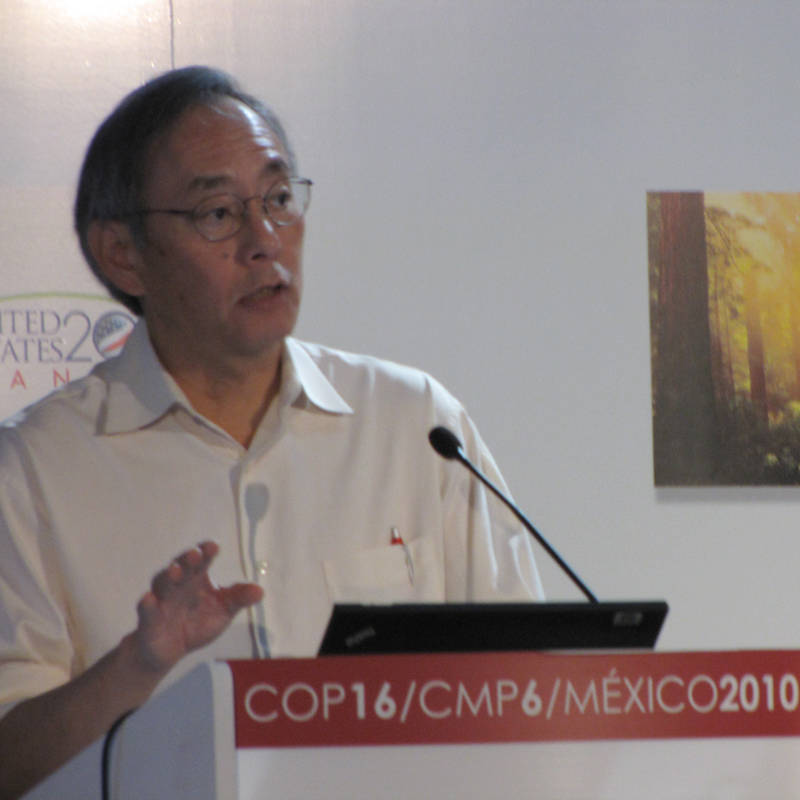Energy Secretary takes the cautious route in Cancun; just part of the sideshow at COP16.

The UN climate negotiations in Cancun may be the official attraction, but in many ways, there’s just as much happening at the “side events” here at COP16. There are dozens everyday — last week there were more than 150, and that number is increasing this week as more people arrive for the final days of the talks. While the negotiations are limited to representatives from national governments, the side events provide a stage for non-governmental organizations (NGOs), scientists, business leaders, and local and regional government officials, many of them, it turns out, from California.
On Monday, US Secretary of Energy Steven Chu, (former head of Lawrence Berkeley National Lab) took the stage to talk about emissions reductions in the US at the national level, and raising eyebrows in the room by taking no questions.
Earlier Lauren Faber of the Cal-EPA spoke on a panel about what California is doing to reduce emissions, highlighting the defeat of Prop 23 (which got a round of applause from the international audience of about 150), California’s efforts to implement a cap-and-trade system, and the state’s vehicle emissions standards, which served as a model for the new federal rules.
Neither talk broke any new ground. In fact, I’d already heard much of Chu’s talk at Stanford earlier this year. He predicted increases in the cost of oil and warned that the damage now being inflicted on the planet won’t be felt for 100 years. Here in Cancun, however, he left out much of the “call to action” that characterized that Stanford speech, opting instead to catalog many of the clean energy tax incentive and R&D programs that the federal stimulus package has funded in the US, under the American Recovery and Reinvestment Act.
Over the weekend, I attended the first-annual Gigaton Awards, which was hosted by Sir Richard Branson’s Carbon War Room and by the Gigaton Throwdown, a group founded by San Francisco-based clean tech investor Sunil Paul that “encourages entrepreneurs, investors and policy makers to grow companies that stabilize the climate.” Awards were given in five categories to companies that had made significant cuts in their own emissions, and, depending on the category, on the influence their products have had on outside emissions.
None of the winners were from California, but the Golden State was well represented at the awards dinner. Attendees included executives from HP, Google, and Hara, a San Mateo-based company that develops software for energy-and-carbon-accounting.
While the side events allow regional governments and businesses to share ideas and celebrate what they consider their achievements, they’re also a venue for organizations and scientists to raise awareness about issues they think are not getting enough attention.
Tony Haymet, director of the Scripps Institute for Oceanography was doing just that on Friday, across the lawn from the UN negotiations at a briefing about ocean acidification.
“Sometimes I feel the science that’s talked about here is from 1965,” he said, adding that the word “ocean” is barely mentioned in the UN climate change negotiating documents.
“This is sort of the tyranny of the atmosphere here at the climate talks,” he said.
Haymet says that because CO2 in the atmosphere “inevitably” dissolves into the ocean, the amount of carbon in the ocean has increased by 30% over the last 150 years. This change in ocean chemistry is harmful for organisms that rely on their calcium carbonate shells.
“If we persist in putting CO2 in the atmosphere and then in the ocean, eventually those organisms won’t be able to make their shells at all,” he said, which would destroy coral reefs, disrupt ocean food chains, and have negative consequences for the world’s commercial fisheries.
“We’re trying to raise a red flag that CO2 has another bad effect,” said Haymet. “The conclusion of all this is very simple. We just have to make electricity without making CO2.”
